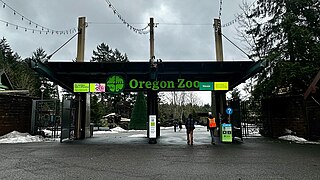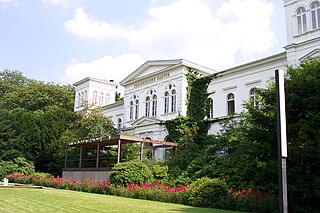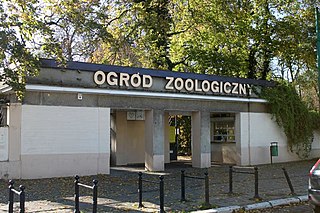
The San Diego Zoo is a zoo in San Diego, California, located in Balboa Park. It began with a collection of animals left over from the 1915 Panama–California Exposition that were brought together by its founder, Dr. Harry M. Wegeforth. The zoo was a pioneer in the concept of open-air, cage-less exhibits that recreate natural animal habitats.

Schönbrunn Zoo is a 17-hectare (42-acre) zoo in the city of Vienna, Austria. Established in 1752, it is the world's oldest zoo still in operation. It is also a UNESCO World Heritage Site, being a part of the Schönbrunn Palace gardens. It generally receives more than 2 million visitors every year.

The Oregon Zoo, originally the Portland Zoo and later the Washington Park Zoo, is a zoo located in Washington Park, Portland, Oregon, approximately 2 miles (3.2 km) southwest of downtown Portland. Founded in 1888, it is the oldest zoo west of the Mississippi River.

Omaha's Henry Doorly Zoo and Aquarium is a zoo in Omaha, Nebraska. It is accredited by the Association of Zoos and Aquariums and a member of the World Association of Zoos and Aquariums. In August 2014, TripAdvisor rated it the "world's best zoo", ahead of the San Diego Zoo and Loro Parque, based on an algorithmic assimilation of millions of reviews for 275 major zoos worldwide.

Hellabrunn Zoo is a 40 hectare zoological garden in the Bavarian capital of Munich. The zoo is situated on the right bank of the river Isar, in the southern part of Munich near the quarter of Thalkirchen.

Beijing Zoo is a zoological park in Xizhimen, Xicheng District, Beijing. Founded in 1906 during the late Qing dynasty, it is the oldest zoo in China and oldest public park in northern China. The zoo is also a center of zoological research that studies and breeds rare animals from various continents.

Dublin Zoo, in Phoenix Park, is a zoo in Dublin, Ireland, and one of Dublin's most popular attractions. Established and designed in 1830 by Decimus Burton, it opened the following year. Today it focuses on conservation projects, breeding programmes, and growing awareness for animals. Its stated mission is to "work in partnership with zoos worldwide to make a significant contribution to the conservation of the endangered species on Earth".

The Berlin Zoological Garden is the oldest surviving and best-known zoo in Germany. Opened in 1844, it covers 35 hectares and is located in Berlin's Tiergarten. With about 1,380 different species and over 20,200 animals, the zoo presents one of the most comprehensive collections of species in the world.

Wilhelma is a zoological-botanical garden in Stuttgart, southern Germany, located in the Bad Cannstatt district in the north of the city on the grounds of a historic castle. Wilhelma Zoo is one of the most popular tourist destinations in Baden-Württemberg, seeing more than 2 million visitors annually.

Prague Zoological Garden is a zoo in Prague, Czech Republic. It was opened in 1931 with the goal to "advance the study of zoology, protect wildlife, and educate the public" in the district of Troja in the north of Prague. In 2013, the zoo occupied 58 hectares with 50 hectares in use for exhibits, and housed around 5,000 animals from 676 species, including 132 species listed as threatened.

The Aktiengesellschaft Cologne Zoological Garden is the zoo of Cologne, Germany. Being the third oldest zoo in Germany, it features over 10,000 animals of more than 850 species on more than 20 hectares. The internationally renowned zoo with an attached aquarium and invertebrate exhibit is active in preservational breeding of animals that are in danger of becoming extinct. In addition, in-the-wild conservation efforts and research focussing on animals of Madagascar, Wallacea, and Vietnam are actively promoted and supported via cooperation with Cologne University and local projects, such as in the case of Przewalski's horses.

Denver Zoo Conservation Alliance is an 80-acre (32 ha) nonprofit zoological garden and conservation organization located in City Park of Denver, Colorado, United States. Founded in 1896, it is operated by the Denver Zoological Foundation and funded in part by the Scientific and Cultural Facilities District (SCFD). Its other sources of funding are ticket sales and private donations. It is the most visited paid attraction in Denver.
The Duisburg Zoo, founded on 12 May 1934, is one of the largest zoological gardens in Germany. It is especially well known for its dolphinarium and, since 1994, for breeding koalas.

Wuppertal Zoo is a 24-hectare (59-acre) zoo in Wuppertal, Germany. About 5,000 animals from around the world live at the zoo, representing about 500 species, including apes, monkeys, bears, big cats, elephants, as well as birds, reptiles, and fish.

Inuka was a male polar bear and one of the mascots of the Singapore Zoo. Born and housed in a climate-controlled enclosure, he was the world's only "tropical polar bear".

The Tierpark Berlin is one of two zoos located in Berlin, Germany. It was founded in 1955 and is located in Friedrichsfelde on the former grounds of Friedrichsfelde Palace, which is situated within the zoo. As of 31 December 2013, the zoo houses 7,250 animals from 846 species, in an area of 160 hectares. Tierpark Berlin also features two public exhibits free of charge, one being the Bärenschaufenster for American black bears. The park is also home to the Treskow family's historic family burial ground.

The Karlsruhe Zoo is a city garden with a zoo in the southwest of Karlsruhe, Germany. It also encompasses the outer area; Tierpark Oberwald in the southeast of the city. The main area totals 22 hectares, and the Oberwald Zoo has an area of 16 hectares. A total of around 3000 animals of over 240 species live at the Zoologische Stadtgarten Karlsruhe. The city garden is located north of the Karlsruhe Hauptbahnhof and south of the Karlsruhe Congress between the Karlsruhe districts of Südstadt and Südweststadt. The zoo was opened in 1865, making it one of the oldest zoos in Germany. The city garden and zoo form a common, enclosed area and cannot be visited separately.

The Poznań Old Zoo is one of the oldest zoological gardens in Poland, located in the city of Poznań, Greater Poland Voivodeship. It was founded in 1874 and was included on the register of objects of cultural heritage in 1978 as a unique example of a vivarium. The zoo started as a few animals kept by a restaurant owner in the early 1870s. It can thus be considered the oldest continuously operating Polish zoological garden. Together with the New Zoo in Poznań, which opened in 1974, it forms an integral part of the whole complex known as The Zoological Garden in Poznań.

Osnabrück Zoo, also known as Zoo Osnabrück, is a zoo located in south Osnabrück at the hillside of Schölerberg in Osnabrück, Germany. It was founded under the name "Heimattiergarten", and opened during the summer of 1936. Almost 3000 animals from roughly 300 species can be seen on the 23.5 ha (0.235 km2) land. It is famous for housing the Grolar Bear. This brought about many scientific inquiries into the zoo.

The Saarbrücken Zoo is with over 200.000 visitors annually, and over 1.700 animals from 160 Species the largest Zoo in Saarland. The Zoo is specialized in African animals.


























